
Rail profile
Encyclopedia
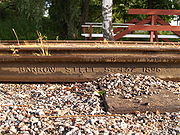

In all but very early cast iron
Cast iron
Cast iron is derived from pig iron, and while it usually refers to gray iron, it also identifies a large group of ferrous alloys which solidify with a eutectic. The color of a fractured surface can be used to identify an alloy. White cast iron is named after its white surface when fractured, due...
rails, a rail is hot rolled steel
Steel
Steel is an alloy that consists mostly of iron and has a carbon content between 0.2% and 2.1% by weight, depending on the grade. Carbon is the most common alloying material for iron, but various other alloying elements are used, such as manganese, chromium, vanadium, and tungsten...
(once wrought iron
Wrought iron
thumb|The [[Eiffel tower]] is constructed from [[puddle iron]], a form of wrought ironWrought iron is an iron alloy with a very low carbon...
) of a specific cross sectional profile
Profile (engineering)
In standardization, a profile consists of an agreed-upon subset and interpretation of a specification. Many complex technical specifications have many optional features, such that two conforming implementations may not inter-operate due to choosing different sets of optional features to support...
(an asymmetrical I-beam
I-beam
-beams, also known as H-beams, W-beams , rolled steel joist , or double-T are beams with an - or H-shaped cross-section. The horizontal elements of the "" are flanges, while the vertical element is the web...
) designed for use as the fundamental component of railway track.
Unlike some other uses of iron
Iron
Iron is a chemical element with the symbol Fe and atomic number 26. It is a metal in the first transition series. It is the most common element forming the planet Earth as a whole, forming much of Earth's outer and inner core. It is the fourth most common element in the Earth's crust...
and steel
Steel
Steel is an alloy that consists mostly of iron and has a carbon content between 0.2% and 2.1% by weight, depending on the grade. Carbon is the most common alloying material for iron, but various other alloying elements are used, such as manganese, chromium, vanadium, and tungsten...
, railway rails are subject to very high stresses and have to be made of very high quality steel. It took many decades to improve the quality of the materials, including the change from iron to steel. Minor flaws in the steel that pose no problems in reinforcing rods for buildings can, however, lead to broken rails and dangerous derailment
Derailment
A derailment is an accident on a railway or tramway in which a rail vehicle, or part or all of a train, leaves the tracks on which it is travelling, with consequent damage and in many cases injury and/or death....
s when used on railway tracks.
By and large, the heavier the rails and the rest of the trackwork, the heavier and faster the train
Train
A train is a connected series of vehicles for rail transport that move along a track to transport cargo or passengers from one place to another place. The track usually consists of two rails, but might also be a monorail or maglev guideway.Propulsion for the train is provided by a separate...
s these tracks can carry.
The rails represent a substantial fraction of the cost of a railway line. Only a small number of rail sizes are made by steelworks at one time, so a railway must choose the nearest suitable size. Worn, heavy rail from a mainline is often reclaimed and downgraded for re-use on a branchline
Branch line
A branch line is a secondary railway line which branches off a more important through route, usually a main line. A very short branch line may be called a spur line...
, siding
Rail siding
A siding, in rail terminology, is a low-speed track section distinct from a running line or through route such as a main line or branch line or spur. It may connect to through track or to other sidings at either end...
or yard
Classification yard
A classification yard or marshalling yard is a railroad yard found at some freight train stations, used to separate railroad cars on to one of several tracks. First the cars are taken to a track, sometimes called a lead or a drill...
.
Rail weights and sizes
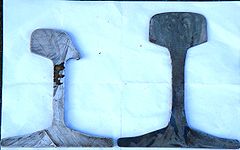
Weights are measured in pounds per yard or kilograms per metre; the pounds-per-yard figure is almost exactly double the kilograms-per-metre figure. Rails in Canada
Canada
Canada is a North American country consisting of ten provinces and three territories. Located in the northern part of the continent, it extends from the Atlantic Ocean in the east to the Pacific Ocean in the west, and northward into the Arctic Ocean...
, the United Kingdom
United Kingdom
The United Kingdom of Great Britain and Northern IrelandIn the United Kingdom and Dependencies, other languages have been officially recognised as legitimate autochthonous languages under the European Charter for Regional or Minority Languages...
and United States
United States
The United States of America is a federal constitutional republic comprising fifty states and a federal district...
are still described using imperial units. In Australia
Australia
Australia , officially the Commonwealth of Australia, is a country in the Southern Hemisphere comprising the mainland of the Australian continent, the island of Tasmania, and numerous smaller islands in the Indian and Pacific Oceans. It is the world's sixth-largest country by total area...
, metric units are now used as in mainland Europe
Continental Europe
Continental Europe, also referred to as mainland Europe or simply the Continent, is the continent of Europe, explicitly excluding European islands....
.
In rail terminology Pound is used synonymously with pounds per yard, e.g. a 132 pound rail means a rail of 132 lb/yd.
Europe
Rails are made in a large number of different sizes. Some common European rail sizes include:In the countries of former USSR
Post-Soviet states
The post-Soviet states, also commonly known as the Former Soviet Union or former Soviet republics, are the 15 independent states that split off from the Union of Soviet Socialist Republics in its dissolution in December 1991...
65 kg/m rails and 75 kg/m rails (not thermally hardened) are common. Thermally hardened 75 kg/m rails also have been used on heavy-duty railroads like Baikal-Amur Mainline, but have proven themselves deficient in operation and were mainly rejected in favor of 65 kg/m rails.
North America
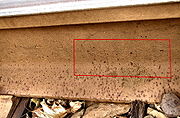
American Society of Civil Engineers
The American Society of Civil Engineers is a professional body founded in 1852 to represent members of the civil engineering profession worldwide. It is the oldest national engineering society in the United States. ASCE's vision is to have engineers positioned as global leaders who strive toward...
(or ASCE) specified rail profiles in 1893 for 5 lb/yd increments from 40 lb/yd. Height of rail equaled width of foot for each ASCE tee-rail weight; and the profiles specified fixed proportion of weight in head, web and foot of 42%, 21% and 37%, respectively. ASCE 90 lb/yd profile was adequate; but heavier weights were less satisfactory. In 1909 the American Railway Association
American Railway Association
The American Railway Association was an industry trade group representing railroads in the United States. The organization had its inception in meetings of General Managers and ranking railroad operating officials known as Time Table Conventions, the first of which was held on October 1, 1872, at...
(or ARA) specified standard profiles for 10 lb/yd increments from 60 lb/yd. The American Railway Engineering Association (or AREA) specified standard profiles for 100 lb/yd, 110 lb/yd and 120 lb/yd rails in 1919, for 130 lb/yd and 140 lb/yd rails in 1920, and for 150 lb/yd rails in 1924. The trend was to increase rail height/foot-width ratio and strengthen the web. Disadvantages of the narrower foot were overcome through use of tie-plates. AREA recommendations reduced the relative weight of rail head down to 36%, while alternative profiles reduced head weight to 33% in heavier weight rails. Attention was also focused on improved fillet radii to reduce stress concentration at the web junction with the head. AREA recommended the ARA 90 lb/yd profile. Old ASCE rails of lighter weight remained in use, and satisfied the limited demand for light rail for a few decades. AREA merged into the American Railway Engineering and Maintenance-of-Way Association
American Railway Engineering and Maintenance-of-Way Association
The American Railway Engineering and Maintenance-of-Way Association is a North American railway industry group. It publishes recommended practices for the design, construction and maintenance of railway infrastructure, which are requirements in the United States and Canada.-Overview:AREMA is...
in 1997. By the mid-20th century, most rail production was medium heavy (112 lb/yd) and heavy (127 lb/yd) Sizes under 100 lb/yd rail are usually for lighter duty freight, low use trackage, or light rail
Light rail
Light rail or light rail transit is a form of urban rail public transportation that generally has a lower capacity and lower speed than heavy rail and metro systems, but higher capacity and higher speed than traditional street-running tram systems...
. Track using (100 lb/yd) rail is for lower speed freight branch line
Branch line
A branch line is a secondary railway line which branches off a more important through route, usually a main line. A very short branch line may be called a spur line...
s or rapid transit
Rapid transit
A rapid transit, underground, subway, elevated railway, metro or metropolitan railway system is an electric passenger railway in an urban area with a high capacity and frequency, and grade separation from other traffic. Rapid transit systems are typically located either in underground tunnels or on...
(for example, most of the New York City Subway
New York City Subway
The New York City Subway is a rapid transit system owned by the City of New York and leased to the New York City Transit Authority, a subsidiary agency of the Metropolitan Transportation Authority and also known as MTA New York City Transit...
system track is constructed with 100 lb/yd rail). Main line track is usually built with 130 lb/yd rail or heavier. Some common North American rail sizes include:
| (ASCE) (ASCE) (ARA) (AREA) New York Central Railroad New York Central Railroad The New York Central Railroad , known simply as the New York Central in its publicity, was a railroad operating in the Northeastern United States... (AREA) Colorado Fuel and Iron Colorado Fuel and Iron The Colorado Fuel and Iron Company was a large steel concern. By 1903, it was largely owned and controlled by John D. Rockefeller and Jay Gould's financial heirs. While it came to control many plants throughout the country, its main plant was a steel mill on the south side of Pueblo, Colorado... |
New York Central Railroad New York Central Railroad The New York Central Railroad , known simply as the New York Central in its publicity, was a railroad operating in the Northeastern United States... (AREA) (AREA) Colorado Fuel and Iron Colorado Fuel and Iron The Colorado Fuel and Iron Company was a large steel concern. By 1903, it was largely owned and controlled by John D. Rockefeller and Jay Gould's financial heirs. While it came to control many plants throughout the country, its main plant was a steel mill on the south side of Pueblo, Colorado... (AREA) (produced by Nippon (Japan)) (no longer production) Pennsylvania Railroad Pennsylvania Railroad The Pennsylvania Railroad was an American Class I railroad, founded in 1846. Commonly referred to as the "Pennsy", the PRR was headquartered in Philadelphia, Pennsylvania.... |
Some common North American crane rail sizes include:
Australia
Some common Australian rail sizes include:| (no longer production) |
- 50 kg and 60 kg are the current standard, although some other sizes are still manufactured.
- Some American sizes are used on northwest Western AustraliaWestern AustraliaWestern Australia is a state of Australia, occupying the entire western third of the Australian continent. It is bounded by the Indian Ocean to the north and west, the Great Australian Bight and Indian Ocean to the south, the Northern Territory to the north-east and South Australia to the south-east...
n iron ore railways.
History


Wagonway
Wagonways consisted of the horses, equipment and tracks used for hauling wagons, which preceded steam powered railways. The terms "plateway", "tramway" and in someplaces, "dramway" are also found.- Early developments :...
s, originally with wooden rails, but from the 1760s using strap-iron rails, which consisted of thin strips of cast iron fixed onto wooden rails. These rails were too fragile to carry heavy loads, but because the initial construction cost was less, this method was sometimes used to quickly build an inexpensive rail line. Strap rails sometimes separated from the wooden base and speared into the floor of the carriages above, creating what was referred to as a "snake head." However, the long-term expense involved in frequent maintenance outweighed any savings.
These were superseded by cast iron rails which were flanged (i.e. 'L' shaped) with the wagon wheels being flat, an early exponent being Benjamin Outram
Benjamin Outram
Benjamin Outram was an English civil engineer, surveyor and industrialist. He was a pioneer in the building of canals and tramways.-Personal life:...
. His partner William Jessop
William Jessop
William Jessop was an English civil engineer, best known for his work on canals, harbours and early railways in the late 18th and early 19th centuries.-Early life:...
had pioneered the use of "edge rails" in 1789 where the wheels were flanged and, over time it was realised that these worked better.
The earliest of these in general use were the so-called cast iron
Cast iron
Cast iron is derived from pig iron, and while it usually refers to gray iron, it also identifies a large group of ferrous alloys which solidify with a eutectic. The color of a fractured surface can be used to identify an alloy. White cast iron is named after its white surface when fractured, due...
fishbelly rails from their shape. Rails made from cast iron
Cast iron
Cast iron is derived from pig iron, and while it usually refers to gray iron, it also identifies a large group of ferrous alloys which solidify with a eutectic. The color of a fractured surface can be used to identify an alloy. White cast iron is named after its white surface when fractured, due...
were brittle
Brittle
A material is brittle if, when subjected to stress, it breaks without significant deformation . Brittle materials absorb relatively little energy prior to fracture, even those of high strength. Breaking is often accompanied by a snapping sound. Brittle materials include most ceramics and glasses ...
and broke easily. They could only be made in short lengths which would soon become uneven. John Birkinshaw
John Birkinshaw
John Birkinshaw was a 19th Century railway engineer from Bedlington, Northumberland noted for his invention of wrought iron rails in 1820. Up to this point, rail systems had used either wooden rails, which were totally incapable of supporting steam engines, or cast iron rails typically only 3 feet...
's 1820 patent, as rolling techniques improved, introduced wrought iron
Wrought iron
thumb|The [[Eiffel tower]] is constructed from [[puddle iron]], a form of wrought ironWrought iron is an iron alloy with a very low carbon...
in longer lengths, replaced cast iron and contributed significantly to the explosive growth of railroads in the period 1825-40. The cross-section varied widely from one line to another, but were of three basic types as shown in the diagram. The parallel cross-section which developed in later years was referred to as Bullhead.
Meanwhile, in May 1831, the first flanged T rail (also called T-section) arrived in America from Britain and was laid into the Pennsylvania Railroad
Pennsylvania Railroad
The Pennsylvania Railroad was an American Class I railroad, founded in 1846. Commonly referred to as the "Pennsy", the PRR was headquartered in Philadelphia, Pennsylvania....
by Camden and Amboy Railroad. They were also used by Charles Vignoles
Charles Blacker Vignoles
Charles Blacker Vignoles was an influential early railway engineer, and eponym of the Vignoles rail.- Early life :...
in Britain.
The first steel
Steel
Steel is an alloy that consists mostly of iron and has a carbon content between 0.2% and 2.1% by weight, depending on the grade. Carbon is the most common alloying material for iron, but various other alloying elements are used, such as manganese, chromium, vanadium, and tungsten...
rails were made in 1857 by Robert Forester Mushet
Robert Forester Mushet
Robert Forester Mushet was a British metallurgist and businessman, born April 8, 1811, in Coleford, in the Forest of Dean, Gloucestershire, England. He was the youngest son of Scottish parents, Agnes Wilson and David Mushet; an ironmaster, formerly of the Clyde, Alfreton and Whitecliff...
, who laid them at Derby station
Derby Midland railway station
Derby railway station , also known as Derby Midland Station, is a main line railway station serving the city of Derby in England. Owned by Network Rail and managed by East Midlands Trains, the station is also used by CrossCountry services and one Northern Rail service...
in England
England
England is a country that is part of the United Kingdom. It shares land borders with Scotland to the north and Wales to the west; the Irish Sea is to the north west, the Celtic Sea to the south west, with the North Sea to the east and the English Channel to the south separating it from continental...
. Steel is a much stronger material, which steadily replaced iron for use on railway rail and allowed much longer lengths of rails to be rolled.
The American Railway Engineering Association (AREA) and the American Society for Testing Materials
ASTM International
ASTM International, known until 2001 as the American Society for Testing and Materials , is an international standards organization that develops and publishes voluntary consensus technical standards for a wide range of materials, products, systems, and services...
(ASTM) specified carbon, manganese, silicon and phosphorus content for steel rails. Tensile strength increases with carbon content, while ductility decreases. AREA and ASTM specified 0.55 to 0.77 percent carbon in 70 lb/yd rail, 0.67 to 0.80 percent in rail weights from 90 lb/yd, and 0.69 to 0.82 percent for heavier rails. Manganese increases strength and resistance to abrasion. AREA and ASTM specified 0.6 to 0.9 percent manganese in 70 to 90 pound rail and 0.7 to 1 percent in heavier rails. Silicon is preferentially oxidised by oxygen and is added to reduce the formation of weakening metal oxides in the rail rolling and casting procedures. AREA and ASTM specified 0.1 to 0.23 percent silicon. Phosphorus and sulfur are impurities causing brittle rail with reduced impact-resistance. AREA and ASTM specified maximum phosphorus concentration of 0.04 percent.
The use of welded rather than jointed track began in around the 1940s and had become widespread by the 1960s.
Flanged rail
Flanged rail was an early type of rail and had an 'L' cross section in which the flange kept an unflanged wheel on the track. The flanged rail has seen a minor revival as the Guided busGuided bus
Guided buses are buses steered for part or all of their route by external means, usually on a dedicated track. This track, which often parallels existing roads, excludes other traffic, permitting the maintenance of reliable schedules on heavily used corridors even during rush hours.Guidance systems...
. In the Cambridgeshire guided busway
Cambridgeshire Guided Busway
The Cambridgeshire Guided Busway , branded the busway , is a public transport scheme connecting the population centres of Cambridge, Huntingdon and St Ives in the English county of Cambridgeshire...
the rail is a 350 mm thick concrete beam with a 180 mm lip to form the flange. The buses run on normal road wheels with side mounted guidewheels to run against the flanges. Buses are steered normally when off the busway, analogous to the 18th C wagons which could be manouvered around pitheads before joining the track for the longer haul.
Baulk rail
Baulk road was an early type of longitudinally supported rail, pioneered by Isambard Kingdom BrunelIsambard Kingdom Brunel
Isambard Kingdom Brunel, FRS , was a British civil engineer who built bridges and dockyards including the construction of the first major British railway, the Great Western Railway; a series of steamships, including the first propeller-driven transatlantic steamship; and numerous important bridges...
.
Barlow rail
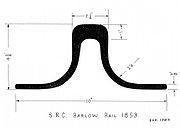
Barlow rail was invented by William Henry Barlow
William Henry Barlow
On 28 December 1879, the central section of the North British Railway's bridge across the River Tay near Dundee collapsed in the Tay Bridge disaster as an express train crossed it in a heavy storm. All 75 passengers and crew on the train were killed...
in 1849. It was designed to be laid straight onto the ballast
Track ballast
Track ballast forms the trackbed upon which railway sleepers or railroad ties are laid. It is packed between, below, and around the ties. It is used to facilitate drainage of water, to distribute the load from the railroad ties, and also to keep down vegetation that might interfere with the track...
, but the lack of sleepers
Railroad tie
A railroad tie/railway tie , or railway sleeper is a rectangular item used to support the rails in railroad tracks...
meant that it was difficult to keep it in gauge
Rail gauge
Track gauge or rail gauge is the distance between the inner sides of the heads of the two load bearing rails that make up a single railway line. Sixty percent of the world's railways use a standard gauge of . Wider gauges are called broad gauge; smaller gauges, narrow gauge. Break-of-gauge refers...
.
Vignoles rail

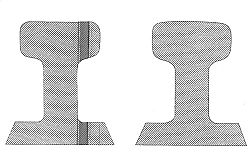
Rail tracks
The track on a railway or railroad, also known as the permanent way, is the structure consisting of the rails, fasteners, sleepers and ballast , plus the underlying subgrade...
, recognising engineer Charles Vignoles who introduced it to Britain
United Kingdom of Great Britain and Ireland
The United Kingdom of Great Britain and Ireland was the formal name of the United Kingdom during the period when what is now the Republic of Ireland formed a part of it....
.
Flat bottomed rail was first introduced in America by R.L.Stevens
Robert Livingston Stevens
Colonel Robert Livingston Stevens was the son of Colonel John Stevens. In 1807, the father and son built the Phœnix, a steamship which became the first steamship to navigate the ocean successfully when she traveled from New York City to the Delaware River in 1809...
in 1830. There were no steel mills in America capable of rolling long lengths, so it was manufactured in Britain. Charles Vignoles observed that wear was occurring with steel rails and steel chairs upon stone blocks, the normal system at that time. In 1836 he recommended flat-bottomed rail to the London and Croydon Railway
London and Croydon Railway
The London and Croydon Railway was an early railway which operated between London and Croydon in England. It was opened in 1839 and in July 1846 it merged with other railways to form a part of the London Brighton and South Coast Railway ....
for which he was consulting engineer.
His original rail had a smaller cross-section to the Stevens rail, with a wider base than modern rail, fastened with screws through the base. Other lines which adopted it were the Hull and Selby
Hull and Selby Railway
The Hull and Selby Railway was a railway company in the United Kingdom which opened in 1840, connecting Hull with the Leeds and Selby Railway-Origins:...
, the Newcastle and North Shields, and the Manchester, Bolton and Bury Canal Navigation and Railway Company.
Manchester, Bolton and Bury Canal
The Manchester Bolton & Bury Canal is a disused canal in Greater Manchester, England, built to link Bolton and Bury with Manchester. The canal, when fully opened, was 15 miles 1 furlong long. It was accessed via a junction with the River Irwell in Salford...
When it became possible to preserve wooden sleepers with mercuric chloride (a process called Kyanising) and creosote
Creosote
Creosote is the portion of chemical products obtained by the distillation of a tar that remains heavier than water, notably useful for its anti-septic and preservative properties...
, they gave a much quieter ride than stone blocks and it was possible to fasten the rails directly using clips or rail spikes. Their use spread worldwide and acquired Vignoles' name.
Flanged T rail
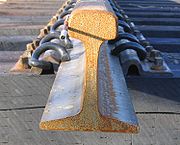
England
England is a country that is part of the United Kingdom. It shares land borders with Scotland to the north and Wales to the west; the Irish Sea is to the north west, the Celtic Sea to the south west, with the North Sea to the east and the English Channel to the south separating it from continental...
which was the only place where his flanged T rail (also called T-section) could be rolled. Railways in England had been using rolled rail of other cross-sections which the ironmaster
Ironmaster
An ironmaster is the manager – and usually owner – of a forge or blast furnace for the processing of iron. It is a term mainly associated with the period of the Industrial Revolution, especially in Great Britain....
s had produced.
In May, 1831, the first 500 rails, each 15 feet (4.57 m) long and weighing 36 lb/yd, reached Philadelphia and were placed in the track, marking the first use of the flanged T rail. Afterwards, the flanged T rail became employed by all railroads in the United States
United States
The United States of America is a federal constitutional republic comprising fifty states and a federal district...
.
Col. Stevens also invented the hooked spike for attaching the rail to the crosstie
Railroad tie
A railroad tie/railway tie , or railway sleeper is a rectangular item used to support the rails in railroad tracks...
(or sleeper). At the present time, the screw spike is being used widely in place of the hooked spike.
The joint where two rails are connected is the weakest part of a rail line. The earliest iron rails were joined by a simple fishplate or bar of metal bolted through the web of the rail. Stronger methods of joining two rails together have been developed. When sufficient metal is put into the rail joint, the joint is almost as strong as the rest of the rail length. The noise generated by trains passing over the rail joints, described as "the clickity clack of the railroad track", can be eliminated by welding the rail sections together forming a continuous rail. One kind of welding is the Thermite welding process.
Double-headed rail
In late 1830s EnglandEngland
England is a country that is part of the United Kingdom. It shares land borders with Scotland to the north and Wales to the west; the Irish Sea is to the north west, the Celtic Sea to the south west, with the North Sea to the east and the English Channel to the south separating it from continental...
, railway lines had a vast range of different patterns. One of the earliest lines to use double-headed rail was the London and Birmingham Railway
London and Birmingham Railway
The London and Birmingham Railway was an early railway company in the United Kingdom from 1833 to 1846, when it became part of the London and North Western Railway ....
, which had offered a prize for the best design. This rail was supported by chairs and the head and foot of the rail had the same profile. The supposed advantage was that, when the head became worn, the rail could be turned over and re-used. In practice, this form of recycling was not very successful as the chair caused dents in the lower surface, and double-headed rail evolved into bullhead rail in which the head was more substantial than the foot.
Bullhead rail
Bullhead rail is similar to double-headed rail but with a heavier profile to the top edge. It became the standard for the British railway system until the mid-20th century but has now been largely replaced by flat-bottom rail. Bullhead rail is still used on the London UndergroundLondon Underground
The London Underground is a rapid transit system serving a large part of Greater London and some parts of Buckinghamshire, Hertfordshire and Essex in England...
and survives on the national rail system in some sidings
Rail siding
A siding, in rail terminology, is a low-speed track section distinct from a running line or through route such as a main line or branch line or spur. It may connect to through track or to other sidings at either end...
or branch lines. One of the first British Standards
British Standards
British Standards are the standards produced by BSI Group which is incorporated under a Royal Charter...
, BS 9, was for bullhead rail - it was originally published in 1905, and revised in 1924. Rails manufactured to the 1905 standard were referred to as "O.B.S." (Original), and those manufactured to the 1924 standard as "R.B.S." (Revised).
Tangential turnouts
Old style turnouts use the same section rail for both stock rail and switch rail. A lot of steel has to be "filed" away, and the point tends to be thin and weak. To minimise the weak part, the switches are straight and form a coarse angle, which gives trains a jolt.Tangential turnouts are made using two different rail profiles, the normal flat bottom rail for the stock rails, and a lower height and stockier profile for the switches. The difference in height of these two profiles is about 25mm, but as the switch rail rests on a base plate 25mm taller, both rails present themselves at the same height to the wheels.
The tangential switch rail has less steel filed away, and the mid part of the switch "scallops" into the web of the stock rail for greater strength. The higher baseplate also supports the switch rail better. The stronger switch allows that switch to be curved, reducing any jolt to the train and allowing higher speeds.
Tangential turnouts still lack a transition at the switch, so there is still a jolt at the switch, but much smaller jolt than with the old style turnouts.
The weight of the two types of rail is about the same.
Grooved rail
See also: Grooved rail
A grooved rail, groove rail, or girder rail is a special grooved rail designed for tramway or railway track in pavement or grassed surfaces (grassed track or track in a lawn
Lawn
A lawn is an area of aesthetic and recreational land planted with grasses or other durable plants, which usually are maintained at a low and consistent height. Low ornamental meadows in natural landscaping styles are a contemporary option of a lawn...
). This was invented in 1852 by Alphonse Loubat
Alphonse Loubat
Alphonse Loubat was a French inventor who developed improvements in tram and rail equipment, and helped develop tram lines in New York City and Paris....
, a French inventor who developed improvements in tram and rail equipment, and helped develop tram lines in New York City and Paris. The invention of grooved rail enabled tramways to be laid without causing a nuisance to other road users, except unsuspecting cyclists, who could get their wheels caught in the groove.
The groove needs to be cleaned of gravel and dirt, otherwise the flange on the wheel may be derailed, a problem which also affects the LR55 rail below.
LR55 rail
- See also:Other tram track profiles
LR55 rail is a special rail section, designed for use in embedded tramway track
Tramway track
Tramway track is used on tramways or light rail operations. Grooved rails are often used in order to make street running feasible...
installations. It is a top-suspended rail: the load is transmitted by the rail head, rather than the base. The rail is laid in concrete troughs in slots cut in the roadway; a polyurethane mastic provides a resilient cushion between the rail section and the concrete, minimising transmitted noise, and providing insulation against leakage currents. Since the load is spread across a wider base, it requires less depth for a sub-base than conventional tramway track avoiding the need to disturb existing underground utility services. The installation and maintenance time, and hence cost, is thus greatly reduced. Gauge is maintained by the pavement in which it is installed; there is no need for separate gauging bars between the rails. LR55 has been tested in parts of the Sheffield Supertram
Sheffield Supertram
The Supertram, officially called the Stagecoach Supertram, is a light rail tram system in the City of Sheffield, South Yorkshire, England...
network.
The same rail has been tested to 80 t (78.7 LT; 88.2 ST) axle loadings for mainline use, and can be used in tunnels and other locations where the loading gauge
Loading gauge
A loading gauge defines the maximum height and width for railway vehicles and their loads to ensure safe passage through bridges, tunnels and other structures...
is restricted. Replacing flat bottom girder rails on sleepers and ballast with LR55 in tunnels can increase the head room
Structure gauge
The structure gauge, also called the minimum clearance outline, is the minimum height and width of tunnels and bridges as well as the minimum height and width of the doors that allow a rail siding access into a warehouse...
by a minimum of 300 mm (11.8 in), without the need to excavate the tunnel invert. A method statement to undertake this transformation allows contractors to proceed on an incremental basis without closing the tunnel to rail traffic. Temporary transition rails link flat bottom and LR55 rails, until the conversion is completed. The extra loading gauge can then be used to install OHL electrification, or to move larger rail vehicles. These can include double deck passenger trains and freight trains with high cube (9 in 6 in (2,895.6 mm) ) maritime containers
Intermodal container
An intermodal container is a standardized reusable steel box used for the safe, efficient and secure storage and movement of materials and products within a global containerized intermodal freight transport system...
.
Rail lengths
Rails should be made as long as possible since joints between raillengths are a source of weakness. As manufacturing processes have improved, raillengths have increased. Long rails flex like snakes and there is no problem going around curves.- (In order of date then length)
- 1830
 - 15 feet (4.6m) Liverpool and Manchester RailwayLiverpool and Manchester RailwayThe Liverpool and Manchester Railway was the world's first inter-city passenger railway in which all the trains were timetabled and were hauled for most of the distance solely by steam locomotives. The line opened on 15 September 1830 and ran between the cities of Liverpool and Manchester in North...
- 15 feet (4.6m) Liverpool and Manchester RailwayLiverpool and Manchester RailwayThe Liverpool and Manchester Railway was the world's first inter-city passenger railway in which all the trains were timetabled and were hauled for most of the distance solely by steam locomotives. The line opened on 15 September 1830 and ran between the cities of Liverpool and Manchester in North... - 1850
 - 39 feet (11.9m) (to suit 40 foot gondola wagons)
- 39 feet (11.9m) (to suit 40 foot gondola wagons) - 1950
 - 60 feet (18.3m)
- 60 feet (18.3m) - 2010
 - 853 feet (260m) Bhilai Steel PlantBhilai Steel PlantBhilai Steel Plant, located in Bhilai, Chhattisgarh, is India's only producer of steel rails, and is a major producer of steel plates and structural components.This steel plant was set up with the help of the USSR in 1955...
- 853 feet (260m) Bhilai Steel PlantBhilai Steel PlantBhilai Steel Plant, located in Bhilai, Chhattisgarh, is India's only producer of steel rails, and is a major producer of steel plates and structural components.This steel plant was set up with the help of the USSR in 1955...
Welding of rails into longer lengths was first introduced around 1893.
- 1895
 Hans GoldschmidtHans GoldschmidtJohannes Wilhelm "Hans" Goldschmidt was a German chemist.Born in Berlin, he was a student of Robert Bunsen. His father, Theodor Goldschmidt, was the founder of the chemical company Chemische Fabrik Th...
Hans GoldschmidtHans GoldschmidtJohannes Wilhelm "Hans" Goldschmidt was a German chemist.Born in Berlin, he was a student of Robert Bunsen. His father, Theodor Goldschmidt, was the founder of the chemical company Chemische Fabrik Th... - 1935
 Charles Cadwell, non-ferrous Thermit welding
Charles Cadwell, non-ferrous Thermit welding
Conical or Cylindrical Wheels
It has long been recognised that conicalCone (geometry)
A cone is an n-dimensional geometric shape that tapers smoothly from a base to a point called the apex or vertex. Formally, it is the solid figure formed by the locus of all straight line segments that join the apex to the base...
wheels and rails that are sloped by the same amount follow curves better than cylindrical wheels and vertical rails. A few railways such as Queensland Railways have always had cylindrical wheels until much heavier traffic required a change.
Manufacturers
Rails are made from high quality steel and not in huge quantities compared to other forms of steel, and so the number of manufacturers in any one country tends to be limited.Corus
Corus Group
Tata Steel Europe is a multinational steel-making company headquartered in London, United Kingdom. It is the second-largest steel-maker in Europe and is a subsidiary of Tata Steel of India, one of the ten largest steel producers in the world.Corus Group was formed through the merger of Koninklijke...
(UK) Krupp
ThyssenKrupp
ThyssenKrupp AG is a German multinational conglomerate corporation headquartered in Duisburg Essen, Germany. The corporation consists of 670 companies worldwide. While ThyssenKrupp is one of the world's largest steel producers, the company also provides components and systems for the automotive...
(Germany) OneSteel
OneSteel
OneSteel is an Australian-based mining, ore processing and steel manufacturing company specialising in steel-long products for the construction, mining, transport and agricultural industries...
, Whyalla, South Australia
South Australia
South Australia is a state of Australia in the southern central part of the country. It covers some of the most arid parts of the continent; with a total land area of , it is the fourth largest of Australia's six states and two territories.South Australia shares borders with all of the mainland...
(Australia) ArcelorMittal Steelton, USA Nippon
Nippon
Nippon is a native name for Japan, more formal than Nihon.Nippon can also refer to:-Company names:All of the following companies are based in Japan.*Nikon *Nippon Telegraph and Telephone...
(Japan) Czech Republic
Czech Republic
The Czech Republic is a landlocked country in Central Europe. The country is bordered by Poland to the northeast, Slovakia to the east, Austria to the south, and Germany to the west and northwest....
Bhilai Steel Plant
Bhilai Steel Plant
Bhilai Steel Plant, located in Bhilai, Chhattisgarh, is India's only producer of steel rails, and is a major producer of steel plates and structural components.This steel plant was set up with the help of the USSR in 1955...
, India
India
India , officially the Republic of India , is a country in South Asia. It is the seventh-largest country by geographical area, the second-most populous country with over 1.2 billion people, and the most populous democracy in the world...
Defunct manufacturers
- Bethlehem SteelBethlehem SteelThe Bethlehem Steel Corporation , based in Bethlehem, Pennsylvania, was once the second-largest steel producer in the United States, after Pittsburgh, Pennsylvania-based U.S. Steel. After a decline in the U.S...
(US) - Sydney Steel CorporationSydney Steel CorporationSydney Steel Corporation was a Crown corporation in the Canadian province of Nova Scotia.-Steel comes to Sydney:An integrated steel mill was established on the southeast side of Sydney Harbour in the Whitney Pier neighbourhood of Sydney, Nova Scotia in 1901 by American investors...
(Canada) - Dowlais IronworksDowlais IronworksThe Dowlais Ironworks was a major ironworks and steelworks located at Dowlais near Merthyr Tydfil, in Wales. Founded in the 18th century, it operated until the end of the 20th, at one time in the 19th century being the largest steel producer in the UK...
(Wales)
See also
- Common structural shapes
- Difference between train and tram railsDifference between train and tram railsA railroad or railway is a track where the vehicle travels over two parallel steel bars, called rails. The rails support and guide the wheels of the vehicles, which are traditionally either trains and trams. Modern light rail is a relatively new innovation which combines aspects of those two...
- Grooved rail
- History of rail transport
- Iron rails
- PlatewayPlatewayA plateway is an early kind of railway or tramway or wagonway, with a cast iron rail. They were mainly used for about 50 years up to 1830, though some continued later....
- Rail tracksRail tracksThe track on a railway or railroad, also known as the permanent way, is the structure consisting of the rails, fasteners, sleepers and ballast , plus the underlying subgrade...
- Structural steelStructural steelStructural steel is steel construction material, a profile, formed with a specific shape or cross section and certain standards of chemical composition and mechanical properties...
- Tramway trackTramway trackTramway track is used on tramways or light rail operations. Grooved rails are often used in order to make street running feasible...
- Rail Steel Patent
- Permanent way (history)

